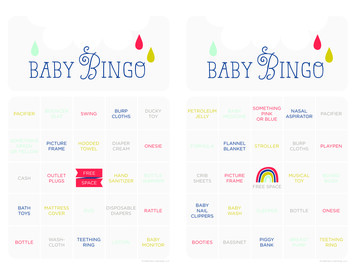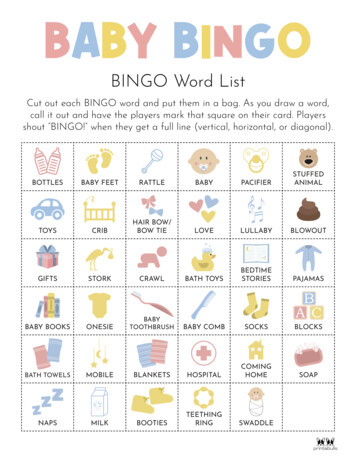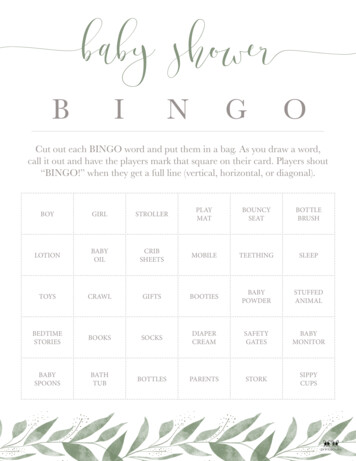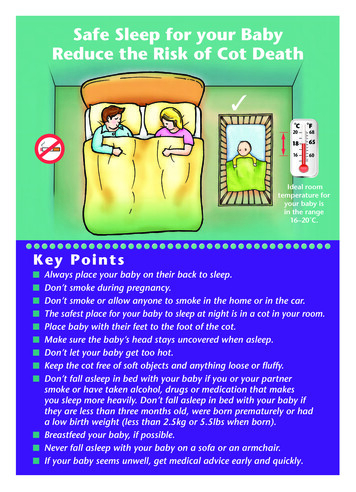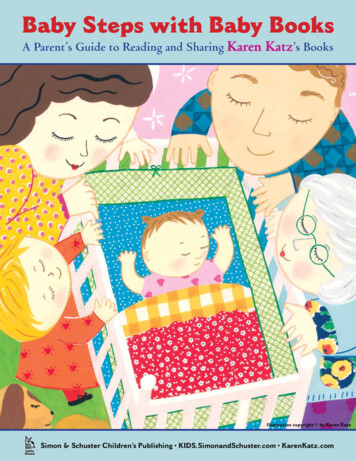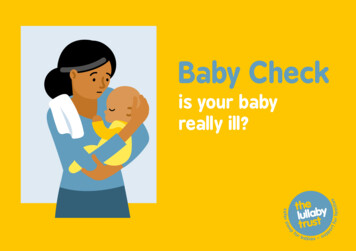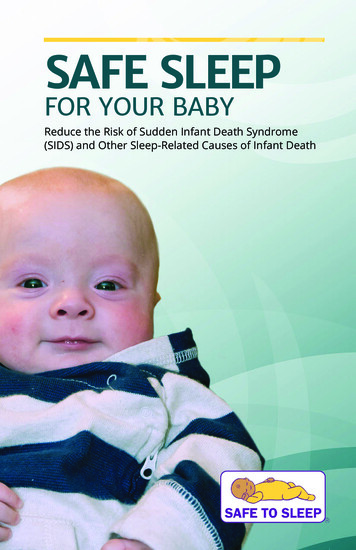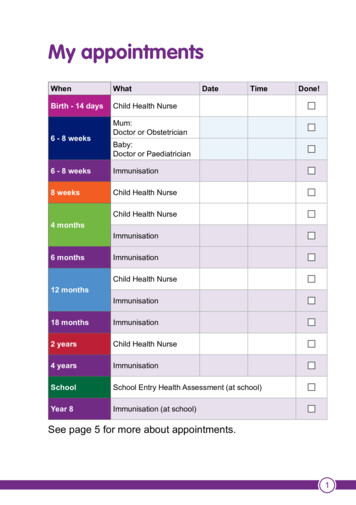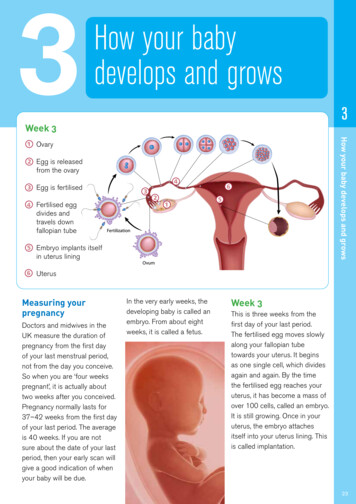
Transcription
3How your babydevelops and grows3Week 3Ovary2Egg is releasedfrom the ovary3Egg is fertilised4Fertilised eggdivides andtravels downfallopian tube5Embryo implants itselfin uterus lining6UterusMeasuring yourpregnancyDoctors and midwives in theUK measure the duration ofpregnancy from the first dayof your last menstrual period,not from the day you conceive.So when you are ‘four weekspregnant’, it is actually abouttwo weeks after you conceived.Pregnancy normally lasts for37–42 weeks from the first dayof your last period. The averageis 40 weeks. If you are notsure about the date of your lastperiod, then your early scan willgive a good indication of whenyour baby will be due.4321In the very early weeks, thedeveloping baby is called anembryo. From about eightweeks, it is called a fetus.How your baby develops and grows165Week 3This is three weeks from thefirst day of your last period.The fertilised egg moves slowlyalong your fallopian tubetowards your uterus. It beginsas one single cell, which dividesagain and again. By the timethe fertilised egg reaches youruterus, it has become a mass ofover 100 cells, called an embryo.It is still growing. Once in youruterus, the embryo attachesitself into your uterus lining. Thisis called implantation.23
Weeks 4–5The embryo now settles intoyour uterus lining. The outercells reach out like roots to linkwith your blood supply. The innercells form two – and then laterthree – layers. Each of theselayers will grow to be differentparts of your baby’s body. Onelayer becomes their brain andnervous system, skin, eyes andears. Another layer becomestheir lungs, stomach and gut.The third layer becomes theirheart, blood, muscles and bones.Week 4The actual size of the embryois about 5mmThe fifth week is when youwill miss your period. At thistime, most women are only justbeginning to think they may bepregnant.32Already your baby’s nervoussystem is starting to develop. Agroove forms in the top layer ofcells. The cells fold up and roundto make a hollow tube called theneural tube. This will becomeyour baby’s brain and spinalcord, so the tube has a ‘headend’ and a ‘tail end’. Defects inthis tube are the cause of spinabifida. The heart is also formingand your baby already has someblood vessels. A string of theseblood vessels connects yourbaby to you – this will becomethe umbilical cord.11The umbilical cord is ababy’s lifeline. It is the linkbetween you and yourbaby. Blood circulatesthrough the cord, carryingoxygen and food to thebaby and carrying wasteaway again.2There is now a large bulgewhere your baby’s heart is and abump for the head because the3242 monthsThe placentaThe placenta is attachedto the lining of theuterus and separatesyour baby’s circulationfrom your circulation.In the placenta, oxygenand food from yourbloodstream pass intoyour baby’s bloodstreamand are carried to yourbaby along the umbilicalcord. Antibodies that giveresistance to infectionpass to your baby inthe same way. Alcohol,nicotine and other drugscan also pass to your babythis way.Weeks 6–71 monthThe umbilical cordThe amniotic sacInside the uterus, the babyfloats in a bag of fluidcalled the amniotic sac.Before or during labourthe sac, or ‘membranes’,break and the fluid drainsout. This is known as the‘waters breaking’.
brain is developing. The heartbegins to beat and can be seenbeating on an ultrasound scan.Week 7The actual size from head tobottom is about 10mmWeek 6The actual size from head tobottom is about 8mmwith a tongue. There are thebeginnings of hands and feet,with ridges where the fingersand toes will be. The majorinternal organs – the heart, brain,lungs, kidneys, liver and gut – areall developing. At nine weeks, thebaby has grown to about 22mmlong from head to bottom.Weeks 8–9Dimples on the side of thehead will become the ears andthere are thickenings wherethe eyes will be. On the body,bumps are forming that willbecome muscles and bones.Small swellings (called ‘limbbuds’) show where the armsand legs are growing. At sevenweeks, the embryo has grownto about 10mm long from headto bottom. This measurement iscalled the ‘crown–rump length’.3 monthsYour baby’s face is slowlyforming. The eyes are moreobvious and have some colourin them. The fetus has a mouthWeek 9The actual size from head tobottom is about 22mmJust 12 weeks after conception,the fetus is fully formed. Yourbaby has all of their organs,muscles, limbs and bones, andtheir sex organs are developed.From now on your baby will growand mature. Your baby is alreadymoving about, but you will notbe able to feel movements yet.By about 14 weeks, your baby’sheartbeat is strong and can beheard by an ultrasound scanner.How your baby develops and growsWeeks 10–143The heartbeat is very fast – abouttwice as fast as a normal adult’sheartbeat. At 14 weeks, the baby4 months5 months25
is about 85mm long from head tobottom. Your pregnancy may startto show, but this varies a lot fromwoman to woman.Week 14The actual size from head tobottom is about 85mmWeeks 15–22Your baby is growing fasterthan at any other time in theirlife. Their body grows biggerso that their head and bodyare more in proportion, andthey don’t look so ‘top heavy’.The face becomes much moredefined and the hair, eyebrowsand eyelashes are beginning togrow. Their eyelids stay closed6 months26over their eyes. Your babyalready has their own individualfingerprints, as the lines on theskin of their fingers are nowformed. Their fingernails andtoenails are growing and theirhands can grip.At about 22 weeks, your babybecomes covered in a very fine,soft hair called lanugo. We don’tknow what this hair is for, but itis thought that it may keep thebaby at the right temperature.The lanugo disappears beforebirth or soon after.Week 22The actual size from head tobottom is about 27cmBetween 16 and 22 weeks, youwill usually feel your baby movefor the first time. If this is yoursecond baby, you may feel itearlier – at about 16–18 weeks.At first, you feel a fluttering orbubbling, or a very slight shiftingmovement. This can feel a bitlike indigestion. Later, you will beable to tell that it is the baby’smovements and you may evensee the baby kicking about.Sometimes you will see a bumpthat is clearly a hand or a foot.Weeks 23–30Your baby is now moving aboutvigorously, and responds totouch and sound. A very loudnoise close by may make themjump and kick.They are also swallowing smallamounts of the amniotic fluid inwhich they are floating, and arepassing tiny amounts of urine7 months8 months
back into the fluid. Sometimesyour baby may get hiccups, andyou can feel the jerk of eachhiccup. Your baby may alsobegin to follow a pattern forwaking and sleeping. Very oftenthis is a different pattern fromyours. So when you go to bedat night, your baby may wake upand start kicking.From 24 weeks, your baby hasa chance of survival if it is born.Week 30The actual size from head tobottom is about 33cmeyes at birth. It is not until someweeks after they are born thatyour baby’s eyes will becomethe colour that they will stay. Thehead-to-bottom length at 30weeks is about 33cm.Weeks 31–40Your baby continues to grow.Their skin, which was quitewrinkled before, becomessmoother, and both the vernixand the lanugo begin todisappear.By about 32 weeks, the babyis usually lying with its headpointing downwards, readyfor birth. The baby’s head can‘engage’, or move down into thepelvis, before birth.Sometimes the head doesn’tengage until labour has started.3How your baby develops and growsYour baby’s heartbeat can beheard through a stethoscope.Later, your partner may be ableto hear the heartbeat by puttingtheir ear to your abdomen, but itcan be difficult to find the rightplace. Your baby is now coveredin a white, greasy substancecalled vernix. It is thought thatthis may be to protect its skin asit floats in the amniotic fluid. Thevernix mostly disappears beforethe birth.Most babies born before thistime cannot live because theirlungs and other vital organsare not developed well enough.The care that can now be givenin neonatal units means thatmore and more babies born thisearly do survive. Babies born ataround this time have increasedrisks of disability. At around 26weeks your baby’s eyelids openfor the first time.A baby’s eyes are almost alwaysblue or dark blue, althoughsome babies do have brown9 months27
baby to you - this will become the umbilical cord. Weeks 6-7 There is now a large bulge where your baby's heart is and a bump for the head because the The umbilical cord The umbilical cord is a baby's lifeline. It is the link between you and your baby. Blood circulates through the cord, carrying oxygen and food to the baby and carrying .
